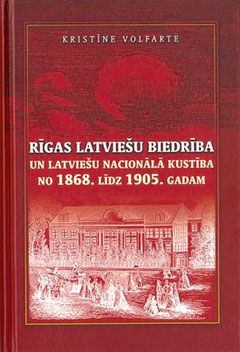The Rīga Latvian Society and its landmark building at Merķeļa iela 13 have played an important role in fostering Latvian national identity. A recently released book, Rīgas Latviešu biedrība un latviešu nacionālā kustība no 1868. līdz 1905. gadam, examines the society’s early history.
Written by historian Kristine Wohlfart, the book is based on the author’s doctoral dissertation. The work was originally published in Germany as Der Rigaer Letten Verein und die lettische Nationalbewegung von 1868 bis 1905 by the Herder-Institut in Marburg.
Wohlfart, who studied philology at the University of Latvia, used the archives of the Rīga Latvian Society in her research. Her analysis, according to press releases announcing the book’s publication, shows that the formation of Latvian identity was not spontaneous, but the result of a concerted effort by activists who wanted to see the development of a modern, politically autonomous nation.
The society was formed in 1868. Its first building was erected in 1869, according to the society’s website, but was destroyed by fire in 1908. The current building was completed in 1909. The society’s activities were suspended in 1940 after the Soviet occupation, but the organization was re-established during the National Awakening period of the late 1980s.
The translation of Wohlfart’s book into Latvian was prepared with support from the Goethe Institute and the German Foreign Ministry.
Rīgas Latviešu biedrība un latviešu nacionālā kustība no 1868. līdz 1905. gadam was published by the University of Latvia.

In a recently released book, German historian Kristine Wohlfart examines the early years of the Rīga Latvian Society.
© 1995-2025 Latvians Online
Please contact us for editorial queries, or for permission to republish material. Disclaimer: The content of Web sites to which Latvians Online provides links does not necessarily reflect the opinion of Latvians Online, its staff or its sponsors.




